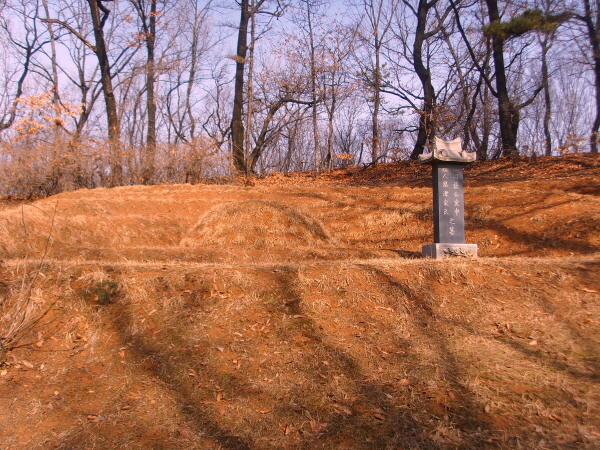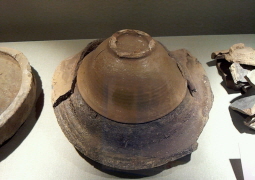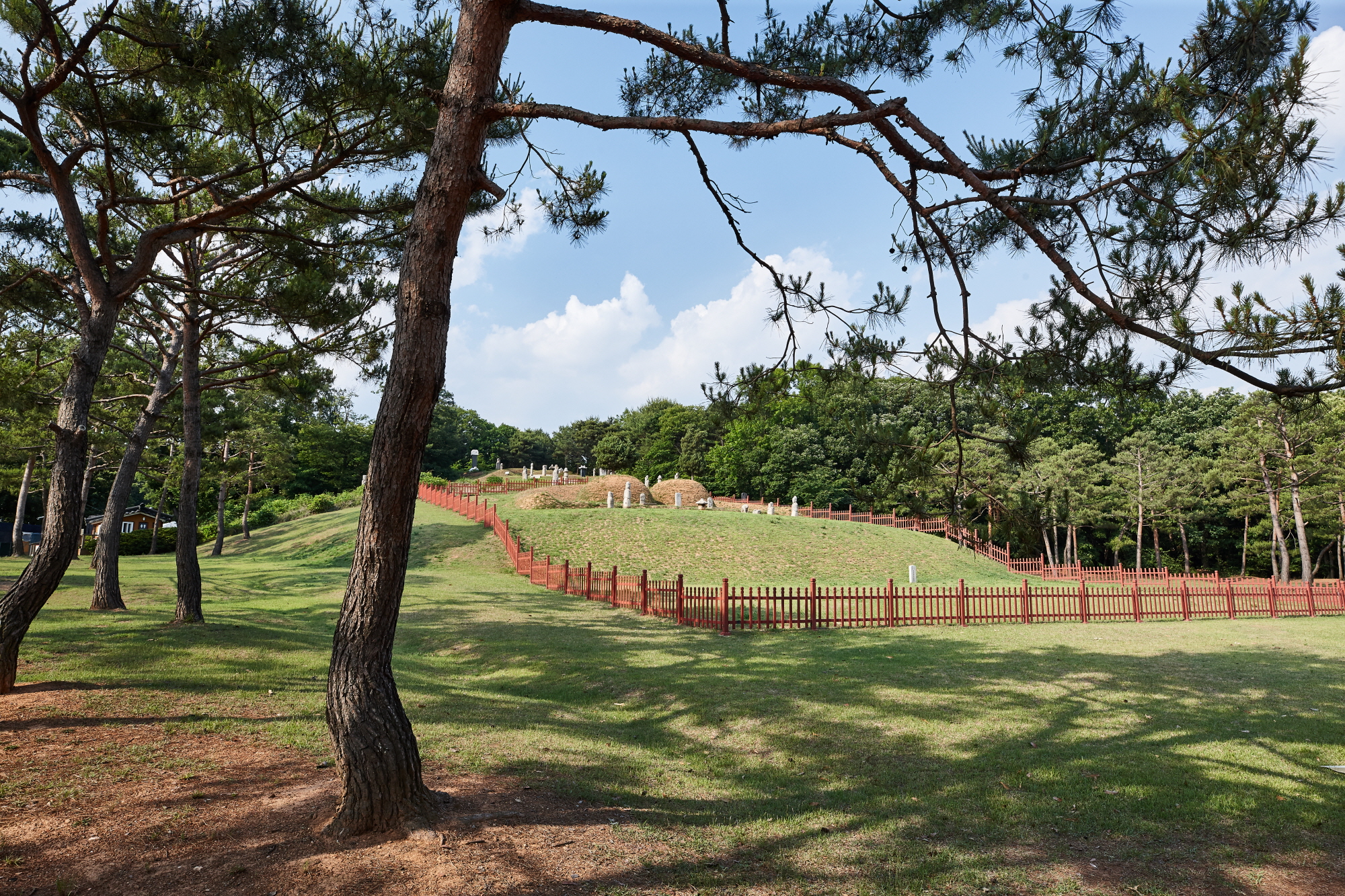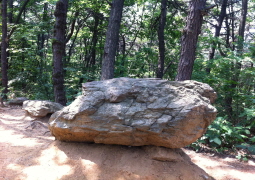
Janguijung, Hyojajungryugak
Tomb of Janguijung, Jungryu, and Hyojamoon are located at the hill behind the restaurant street on the entrance of Wangrerunggol, Wondang-dong, Deokyang-gu. Janguijung Hyojajungryogak is the one and only Confucian relic that is left with Jungryugak and Hyojajunggryu door. Jungryu has been partially re-constructed due to the damage as a gable roofed house in the form of Korean traditional house in the past, and the size of it is two rooms on the front that preserve ancestral tablets and utensils used for ritual ceremony. There is a phrase, 孝子學生 長宜中之閭, in Jungryu. Board of Jungryu door is in red color that there are total eight Hongsals. Hyojamun is supported by steel wires connected from Jungryu. Janguijung is a filial son in the late Joseon Dynasty. As his story was diffused how he cut his finger to cure his mother, he was granted with Jungryu and Hyojamun from Gojong in 1905. There is a tomb of him 30m behind Jungryumun.

Representative kiln site, Wonheung-dong, Cheongjayo
Designation number: Gyeonggi-do cultural asset 64
location: 418-5 Wonheungdong Mountain, Deokyang-gu, Goyang-si, Gyeonggi-do
Wonheong-dong Cheongja kiln site is the relic of Cheongjayo that was used in the 9th to 10th century. It was firstly found by the scholar in Japan, Nomori Ken, when he worked for government general in 1937. It was also one of the important relics included when investigating kiln sites in the nation in 1982. This relic is one of the Cheongja kiln sites in the early days in Korean Peninsula with Seori in Yongin, Bansan-dong in Siheung, and Jungam-ri, Yeoju. There are many of the Cheongjapeons manufactured at that time.
Especially, as there is a close relation with top five celadons in China in terms of the shape of Cheongjapyeon, it is a very important relic in academical perspective. Kiln sites at Wonheong-dong are assumed to be composed of five sites. Rectangle bricks and Cheongjapyeons are found as they were used as Gapbal and kiln sites constructing materials.
Other characteristics of kiln sites at Wonheung-dong are that it is the one and only Cheongjawadang found in this place. Cheongjawadang has been applied with dark brown paint. Celadon roof tiles before 12th century are known to be found only in Wonheung-dong. You can reach to this celabon roof tiles if you turn to the left at three-way intersection about 1km from the inner way in Wonheong-dong village. Cheongjayo at Wonheung-dong is famous as the relic in the end of Shilla and the early Koryo Dynasty.

The tomb of the last king in Koryo, Gongyang
Designation number: Historical site 191
location: 65-1 Wondangdong-san, Deokyang-gu, Goyang-si
In 1368 when it was 17th year in the reign of king Gongmin, Yuan that influenced much on Koryo was chased after by the Ming Dynasty towards the north. The king Gongmin removed the power of Yuan as he took the Ssangsung administration department back in 1356. Furthermore, he suppressed corrupted power and started reformation to establish the royal authority. However, he did not have power to support the reformation that was led by one specific figure, the monk, ‘Sindon.’ Therefore, reformation ended up failing. However, his reformation had laid groundwork for Neo-Confucianism to grow as a new theology for ruling the country and also for new noblemen (Sinjinsadaebu) to gain the power in the future.
After the king Gongmin was dead, the king Woo was known to be born by the king Gongmin and his wife, 般若. However, the power led by Sunggye Lee dethroned him in 1388 as he was a son not of the king Gongmin but of Sindon and supported the king Chang with recommendation from Minsoo Cho and Saek Lee. Later, SUnggye Lee insisted 廢假立眞 to dethrone him again and killed the rival, Young Choi, to gain the power. As Sinjinsadaebu gained all the power based on Sungye Lee, 瑤, the seventh generation of Sinjong, became the king Gongyang. He was very old at that time and simply a setup made by Sunggye Lee. Sunggye Lee proceeded the reformation to create a new country and performed plans step by step to dethrone the king Gongyang in 1392 and became the first king of Joseon as a new country. The name of the king Gongyang was 瑤, and he was the son of Jungwonbuwongyun as the seventh generation of 20th Sinjong. His mother was Mrs. Wang as the queen. Her real last name was Noh as a daughter of Jin from Changsung-gun.
He was smart and wise but a weak king due to the circumstances at that time. After he became the king, he had the king Woo killed at Gangreung and the Changhwang killed at Ganghwa by the power led by Sunggye Lee regardless of his will. In 1392 when Joseon was constructed, he was expelled to Wonju and moved to Gansung-gun thereafter, he was degraded to Gongyang-gun. In 1394, he moved to Samchuk-bu and was killed as expected. During his reign, he made several attempts for reformation in overall areas in society including politics, economics, education, and culture. However, it was a social reformation led by Sinjinsadaebu led by Sunggye Lee. When Mongju Chung was killed as he opposed the power led by Sunggye Lee in 1392, Joon Cho, Dojeon Nam, and Eun Nam dethroned the king Gongyang and made Sunggye Lee as a king. This was the last royal dynasty in Koryo. The tomb of Gongyang is located at Goseong, Samcheok, Gangwon-do and Goyang, Gyeonggi-do. Why has the tomb of Gongyang been established at three places? The king Gongyang was expelled to Wonju and Ganseong and killed in Samcheok in 1394. Therefore, the first tomb of Gongyang was established at Samcheok. Then, Gongyang was supported as a king after he was dethroned in 1416 as the power was stabilized, and tomb seemed to be relocated to Goyang-si as it was near Hanyang, the capital of Joseon and Gaeseong, the capital in Koryo. Hereupon, Cultural Heritage Administration saw that the last place where the king Gongyang was killed was Goyang-si. Therefore, the tomb of Gongyang was designated as the nation cultural heritage number 191, and the tomb at Samcheon was designated as the monument number 71 in Gangwondo
There are many stories of how the tomb of Gongyang was created. This is also a proof showing how the political situations was unstable in the end of Koryo. Objective data that tell the exact location where Gongyang is buried can be found in literature. According to the chronicles in the beginning of Taejong and Sejong, it was made sure that tomb of Gongyang at Wondang was the real tomb. In the reign of Taejong, tomb was repaired in this place establishing the protective area behind the tomb to protect it. In the reign of Sejong, the portrait of the king, Gongyang, was relocated from Chungryong Temple to Goyangghyun according to the order. Other than them, the royal tomb of Gongyang was recorded to be authentic in Goyang when identfiyng royal tombs. However, it is difficult to define the location of the tomb Gongyang only by the literature. This is because circumstances were so unstable at that time. The kings before Gongyang, Woo and Chang, had no tombs. Whether the royal tomb of Gongyang was to be authentic or not is still a riddle in the history by now as there has not been investigation based on excavation.
The village located at about 2km in Wondang-ro towards Byukje (towards north and east from Goyang city hall) is Wangreunggol Village. If you come about 1.2km towards the inside of the village from the entrance of Wangreunggol Village, there is the tomb of Gongyang. Seeing from the front side, the tomb of Gongyang is located on the left side. On the right side, the tomb of Sunbi with last name Noh is located. In front of the tomb, As for stoneworks in front of the tomb, there are the burial mounds of kings and queens. Each of them is written with ‘Koryo Gongyang romb’ and ‘King Gongyang wife.’ However, they are not quite readable. In front of them, there is a Sangseok. There is a pair of plants that seem to be Mun and Muinsok facing to each other.
In the front, there is one Seoksu in the shape of dog. This stonework supports the legend of the ‘Sapsal dog with the king Gongyang’ that was handed down in Goyang-si. However, a figure in the similar shape of this Seoksu is shown in the tomb of Sungryungdaegun. Seoksoo in the tomb of Sungryungdaegun has an image of dog located at each side. There is only one Seoksu on the tomb of Gongyang. However, there is a particle of Seoksu next to it. In fat, there is almost no tomb where there is only one Seoksu in front of the tomb, and the original location of this Seoksu might be next to the tomb of Gongyang.

Dolmen – Guksabong
Designation number: Regional cultural asset in Goyang 56
location: Hwajeong-dong, Seongsa-dong, Deokyang-gu, Goyang-si, Gyeonggi-do
Dolmen at Guksabong is located at Seongsa-dong and Hwajeong-dong in Deokyang-gu. There is a military camp on top of Sungra Park to the east of Uulim Nuri. When you come all the way to the military camp, there is a fork about 200m away from the end of the road. The areas near this place are the dolmen on Guksabong. When you come about 50m from the fork, there are dolmen on the first sight.
Dolmen are the important cultural assets that show the culture in Joseon along with Bipahyungdongbum. The ones on Guksabong are the representative cultura in the Bronze Era left in Goyang-si. They are assumed to be made about 2,500 years ago. Stone knives were found in this place, and there are many of the stones that seem to be dolmen. There is a foundation stone on the gorund at Guksabong. There is also a cover stone on top of it. Stoneworks or Kawaji rice seed in the old stone age have not been designated as the cultural asset. Therefore, dolmen in the Bronze Era near Jirung Mountain and Sungra Mountian are the oldest designated cultural assets.

600 years of the history continues. Goyang-gun office and city hall
Goyang-gun was composed of 12 myeons (Yonggang, Yunhee, Eunpyeong, Soongin, Dokdo, Hanji, Byukje, Sindo, Wondang, Jido, Songpo, and Jungmyeon) and 155 ris in 1914. Goyang-gun office was relocated from Goyang-dong to Chungjeong-ro 1-ga (currnently Seoul Red Cross Hospital). In 1936, Yonggang-myeon, Yunhee-myeon, and Hanji-myeon were transferred to Hansung, and Goyang-gun office was partially transferred to Seoul due to the expansion of administration in Seoul. Goyang-gun only administered six myeons; Wondang, Byukje, Sindo, Jido, Songpo, and Mung. On August, 1961, gun-office was relocated from Seoul to Wondang-myeon. On April, 1989, as the plan for constructing New Ilsan City, the new Ilsan city was being constructed near old Ilsan-eub, Ilsan-ri, Madu-ri, Janghang-ri, Baekseok-ri, and Juyeop-ri in the size of 5.6 million py. Then, as the plan was made to add the Jungsan, Tanhyeon, Sungsa, Hwajeong, Neunggok, and Haengsin districts to the development for the area, Goyang-gun was promoted as Goyang-si on February 1, 1992. Deu to the development of new Ilsan city and the urbanization of Hwajeong, Tanhyeon, Sungsa-dong, Jungsan, and Haengsin, the population increased, and the place was promoted to Goyang-si. Afterwards, new symbols have become rose, lacebark pine tree, and magpie. At the time when the city was promoted, the population was about 240 thousand, and the size of the city was 266.47km2. As of April, 2017, the city was grown big in the population of 1.04 million, and there are three administrative district; Deokyang-gu, Insandong-gu, and Ilsanseo-gu in Goyang-si.




